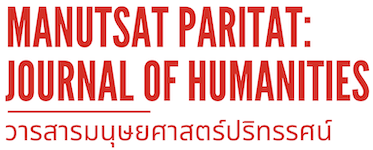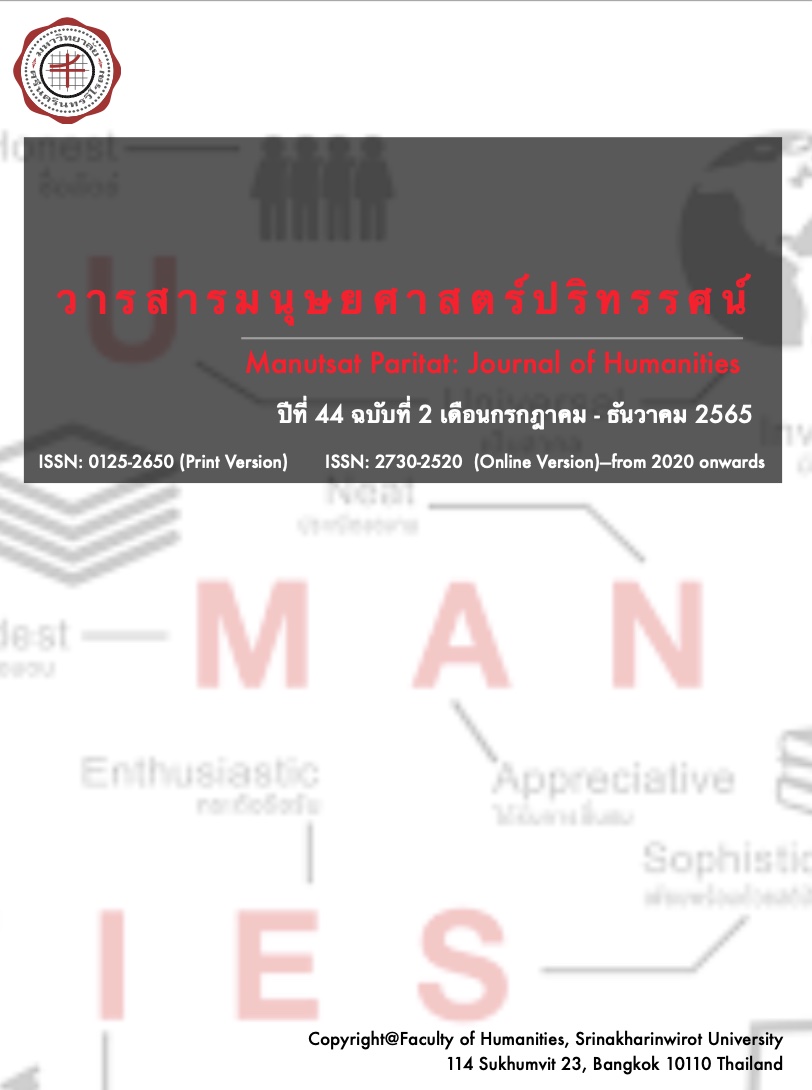The การเลือกปฏิบัติต่างเพศ การจัดการอัตลักษณ์ทางเพศในที่ทำงาน กับความพึงพอใจในการทำงานของพนักงานที่มีอัตลักษณ์หลากหลายทางเพศ
##plugins.themes.bootstrap3.article.main##
摘要
การวิจัยครั้งนี้มีวัตถุประสงค์เพื่อศึกษาความสัมพันธ์ระหว่างการเลือกปฏิบัติต่างเพศในที่ทำงานกับความพึงพอใจในการทำงาน และมีกลยุทธ์การจัดการอัตลักษณ์ทางเพศในที่ทำงานเป็นตัวแปรส่งผ่าน โดยการเก็บข้อมูลผ่านแบบสอบถามออนไลน์จากพนักงานที่มีความหลากหลายทางเพศ 3 กลุ่ม คือ กลุ่มชายรักชาย (gay), กลุ่มหญิงรักหญิง (lesbian) และกลุ่มรักสองเพศ (bisexual) จำนวน 200 คน พบว่า (1) การเลือกปฏิบัติต่างเพศ ในที่ทำงานมีความสัมพันธ์ทางลบต่อความพึงพอใจในการทำงาน กล่าวคือ หากพนักงานรับรู้การเลือกปฏิบัติต่างเพศในระดับสูงในที่ทำงานจะส่งผลทำให้ความพึงพอใจในการทำงานของพนักงานลดลง และ (2) กลยุทธ์ การจัดการอัตลักษณ์ทางเพศในที่ทำงานทั้ง 4 กลยุทธ์ ประกอบด้วย กลยุทธ์การข้ามผ่าน (Passing: PA), กลยุทธ์การปกปิด (Covering: CO), กลยุทธ์การเปิดเผยแบบไม่ได้ตั้งใจ (Implicitly Out: IO) และกลยุทธ์การเปิดเผยอย่างชัดเจน (Explicitly Out: EO) มีอิทธิพลส่งผ่านระหว่างการเลือกปฏิบัติต่างเพศในที่ทำงานกับความพึงพอใจในการทำงานได้อย่างมีนัยสำคัญทางสถิติ หมายความว่า กลยุทธ์การจัดการอัตลักษณ์ทางเพศมีอิทธิพลต่อความสัมพันธ์ระหว่างการเลือกปฏิบัติต่างเพศในที่ทำงานกับความพึงพอใจในการทำงานของพนักงานที่มีความหลากหลายทางเพศ
##plugins.themes.bootstrap3.article.details##
Any unauthorized copying, publication, reproduction or distribution of copyrighted works appeared in Manutsat Paritat: Journal of Humanities is an infringement of the copyright owners’ rights. To authorize the copying, publication, reproduction or distribution of copyrighted works to be appeared in other printed materials or any online media, please write to MPJHthaijo@gmail.com for permission.
参考
ความหลากหลายและการรวมเป็นหนึ่งเดียว. (ม.ป.ป.). การสนับสนุนพนักงาน LGBTมากความสามารถที่เชลล์. https:// www.shell.co.th/th_th/careers/diversity-inclusion/lgbt-talent-at-shell.html
บุษกร สุริยสาร. (2557). อัตลักษณ์และวิถีทางเพศ ในประเทศไทย/องค์การแรงงานระหว่างประเทศประจำประเทศไทย กัมพูชา และ สาธารณรัฐประชาธิปไตยประชาชนลาว; โครงการส่งเสริมสิทธิความหลากหลาย และความเท่าเทียมในโลกของการทำงาน (PRIDE). กรุงเทพ: องค์การแรงงานระหว่างประเทศ.
พิมลพรรณ อิศรภักดี. (2558). ต่างวัยต่างทัศนะต่อความหลากหลายทางเพศในสังคมไทย. กรุงเทพฯ: สถาบันวิจัยประชากรและสังคม มหาวิทยาลัยมหิดล
รัตนวัฒน์ จันทร์อำนวยสุข, Balzer C., & LaGata, C. (2558). การเคารพคนข้ามเพศเปรียบเทียบกับการเกลียดกลัวคนข้าม เพศ ประสบการณ์ทางสังคมของคนข้ามเพศในประเทศไทย. กรุงเทพ: เครือข่าย เพื่อนกะเทยไทย และTransgender Europe (TGEU).
สุรชัย ประกอบ. (2560). ความสามารภในการรับมือกับวัฒนธรรมที่หลากหลายและความคิดสร้างสรรค์ในการทำงานของผู้ที่มีอัตลักษณ์หลากหลายทางเพศ (LGBT) ตามการรับรู้ของบุคลากรภาครัฐ ในจังหวัดสงขลา. (วิทยานิพนธ์รัฐประศาสนศาสตรมหาบัณฑิต). มหาวิทยาลัยสงขลานครินทร์
Anderson, M. Z., Croteau, J. M., Chung, Y. B., & DiStefano, T. M. (2001). Developing an assessment of sexual identity management for lesbian and gay workers. Journal of Career Assessment, 9, 243-260.
https://doi.org/10.1177/106907270100900303
Button, S. B. (2001). Organizational efforts to affirm sexual diversity: A cross-level examination. Journal of Applied Psychology, 86(1), 17.
Cheung, F., & Chan, W. (2021). Sexual identity management strategies and occupational well-being: a latent profile analysis. Journal of Career occupational well-being: a latent profile analysis. Journal of Career Development, 48(4), 430-442. https://doi.org/10.1177/0894845319856113
Chrobot-Mason, D., Button, S. B., & DiClementi, J. D. (2001). Sexual - identity management strategies: An exploration of antecedents and consequences. Sex Roles, 45(5), 321-336
Chung, Y. B. (2001). Work discrimination and coping strategies: Conceptual frameworks for counseling lesbian, gay, and bisexual clients. The Career Development Quarterly, 50(1), 33–44. https://doi.org/10.1002/j.2161-0045.2001.tb00887.x
Cooper, C., & Dewe, P. (2008). Well-being-absenteeism, presenteeism, costs and challenges. Occupational Medicine, 58(8), 522-524.
Crocker, J., & Major, B. (1989). Social stigma and self-esteem: The self-protective properties of stigma. Psychological Review, 96(4), 608.
Croteau, J. M. (1996). Research on the work experiences of lesbian, gay, and bisexual people: An integrative review of methodology and findings. Journal of Vocational Behavior, 48(2), 195-209.
Croteau, J. M., Anderson, M. Z., DiStefano, T. M., & Kampa-Kokesch, S. (2000). Lesbian, gay, and bisexual vocational psychology: Reviewing foundations and planning construction. In R. M. Ruperto, K. A. DeBord, & K. J. Bieschke (Eds.), Handbook of counseling and psychotherapy with lesbian, gay, and bisexual clients (pp. 383-408). Washington, DC: American Psychological Association.
Croteau, J. M., Anderson, M. Z., & VanderWal, B. L. (2008). Models of workplace sexual identity disclosure and management: Reviewing and extending concepts. Group & Organization Management, 33(5), 532-565. https://doi.org/10.1177/1059601108321828
D'augelli, A. R., & Grossman, A. H. (2001). Disclosure of sexual orientation, victimization, and mental health among lesbian, gay, and bisexual older adults. Journal of Interpersonal Violence, 16(10), 1008-1027.
Fassinger, R. E., & Miller, B. A. (1996). Validation of an inclusive model of homosexual identity formation on a sample of gay men. Journal of Homosexuality, 32, 53-78. https://doi.org/10.1300/J082v43n02_05
Fassinger, R. E., & Arseneau, J. R. (2007). “I’d rather get wet than be under that umbrella”: Differentiating the experiences and identities of lesbian, gay, bisexual, and transgender people. In K. Bieschke, R. Perez, & K. DeBord (Eds.), Handbook of counseling and psychotherapy with lesbian, gay, and bisexual clients (2nd ed., pp. 19-50). Washington, DC: American Psychological Association.
George, D., & Mallery, M. (2010). SPSS for Windows step by step: A simple guide and reference, 17.0
Update (10th ed.). Boston: Pearson.
Goffman, E. (1963). Stigma. Englewood Cliffs, NJ: Prentice-Hall.
Griffin, P. (1991). Identity management strategies among lesbian and gay educators. International Journal of Qualitative Studies in Education, 4(3), 189–202. https://doi.org/10.1080/0951839910040301
Griffin, P. (1992). From hiding out to coming out: Empowering lesbian and gay educators. In K.M. Harbeck (Ed.), Coming out of the classroom closet (pp.167-196). Binghamton, NY: Harrington Park Press.
Griffith, K. H., & Hebl, M. R. (2002). The disclosure dilemma for gay men and lesbians: “Coming out” at wo Journal of Applied Psychology, 87, 1191-1199.
Hair 2006 Hair J.F., Black W.C., Babin B.J., Anderson R.E., & Tatham R.L. (2006). Multivariate data analysis (6th ed.). New Jersey: Pearson.
Herek, G. M. (1990). The context of anti-gay violence: Notes on cultural and psychological heterosexism. Journal of Interpersonal Violence, 5(3), 316-333.
Herek, G. M., Kimmel, D. C., Amaro, H., & Melton, G. B. (1991). Avoiding heterosexist bias in psychological research. American Psychologist, 46(9), 957.
Jackson, A. W., & Andrews, G. A. (2000). Turning points 2000: Educating adolescents in the 21st century.
Teachers College Press.
Jung, P. B., & Smith, R. F. (1993). Heterosexism: An ethical challenge. SUNY Press.
King, E. B., Mohr, J. J., Peddie, C. I., Jones, K. P., & Kendra, M. (2017). Predictors of identity management: An exploratory experience - sampling study of lesbian, gay, and bisexual workers. Journal of Management,
(2), 476-502. https://doi.org/10.1177/0149206314539350
Newheiser, A. K., & Barreto, M. (2014). Hidden costs of hiding stigma: Ironic interpersonal consequences of concealing a stigmatized identity in social interactions. Journal of Experimental Social Psychology, 52,58-70.
Ragins, B. R., & Cornwell, J. M. (2001). Pink triangles: antecedents and consequences of perceived workplace
discrimination against gay and lesbian employees. Journal of Applied Psychology, 86(6), 1244. https://doi.org/ 10.1037/0021-9010.86.6.1244
Sears, J. T. (1997). Thinking critically/intervening effectively about homophobia and heterosexism. In J. T. Sears & W. L. Williams (Eds.), Overcoming heterosexism and homophobia: Strategies that work (pp. 13-48). New York: Columbia University Press.
Tatum, A. K., Formica, L. J., & Brown, S. D. (2017). Testing a social cognitive model of workplace sexual identity
management. Journal of Career Assessment, 25(1), 107-120. https://doi.org/10.1177/1069072716659712
Waldo, C. R., Hesson-Mclnnis, M. S., & D'Augelli, A. R. (1998). Antecedents and consequences of victimization of
lesbian, gay and bisexual young people: A structural model comparing rural university and urban samples. American Journal of Community Psychology, 26, 307-334.
Waldo, C. R. (1999). Working in a majority context: A structural model of heterosexism as minority stress in the workplace. Journal of Counseling Psychology, 46(2), 218.
Woods, J. D. (1993). The corporate closet: The professional lives of gay men in America. New York: Free Press.

